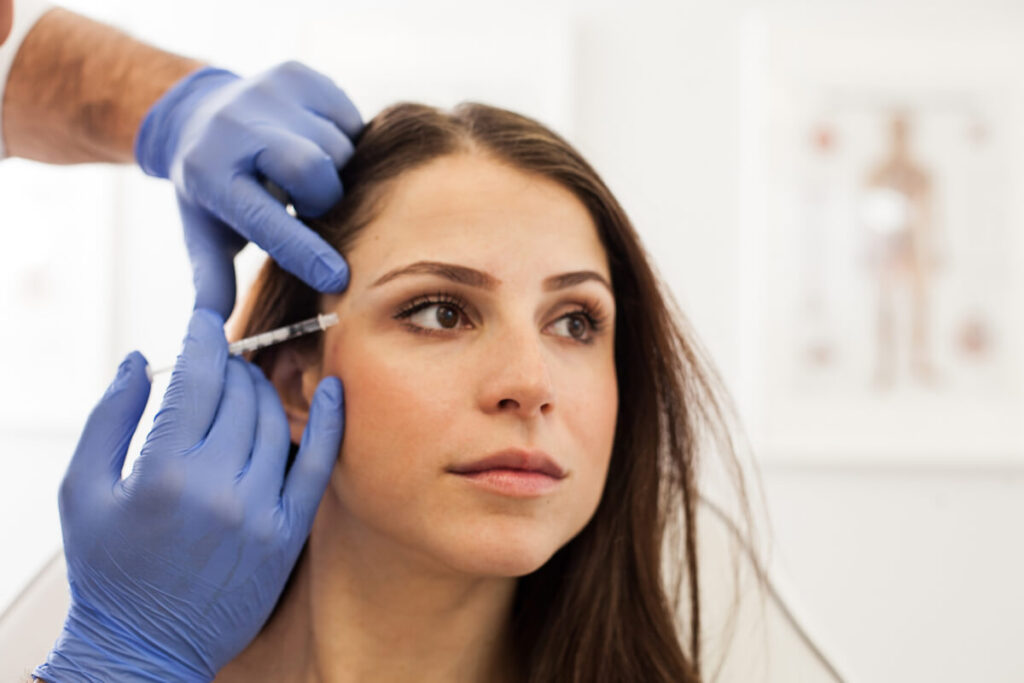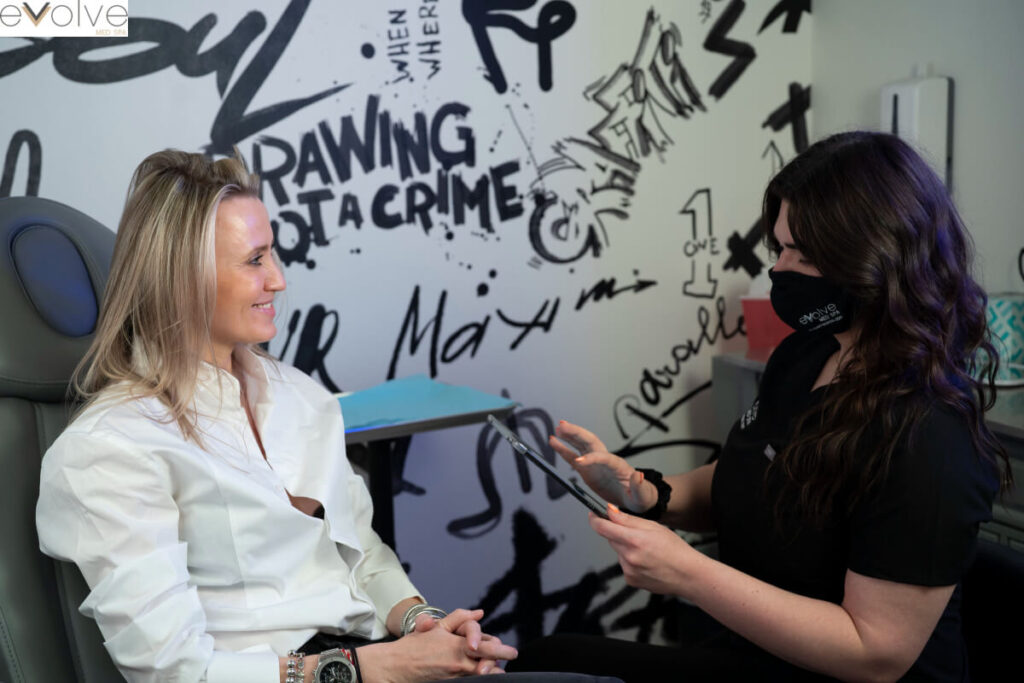Refer a friend, and both you and the person you refer will get $50 off your visit($250 minimum purchase). Learn more!
PRF Gel is here! Smooth fine lines and achieve subtle volume with natural filler. Learn more!

Signs of aging around the eyes, such as droopy eyelids, crow’s feet, dark circles, and sunken eyes, are often the most noticeable. Fortunately, treatments like Botox and dermal fillers offer effective, minimally invasive solutions to rejuvenate this delicate area and create a more rested, youthful appearance.
So, when it comes to the eyes, which is the better choice: Botox or dermal fillers? The answer lies in understanding how each treatment works and the specific concerns being addressed. Dermal fillers excel at restoring lost volume under the eyes, while Botox is highly effective at smoothing dynamic wrinkles like crow’s feet and glabellar (frown) lines.
Both Botox and dermal fillers are leading anti-aging treatments in the United States. According to the American Society of Plastic Surgeons (ASPS), these injectables accounted for approximately 7 million minimally invasive cosmetic procedures in 2020.
While both target signs of aging around the eyes, their mechanisms of action differ significantly. Botox works by relaxing muscles, whereas dermal fillers restore volume. Consulting with a qualified aesthetic medical provider is crucial to determine whether your concerns require “filling” or “relaxing.”

Botox is an injectable substance derived from botulinum toxin type A, a neurotoxin that temporarily blocks nerve signals to muscles. This relaxation of overused muscles beneath the skin smooths out facial lines. Beyond cosmetic applications, Botox is also used to treat medical conditions like excessive sweating, lazy eye, and muscle disorders.
How it Works: During a Botox procedure, a medical provider injects the substance directly into the muscle under the skin of the target area. This temporarily relaxes the facial muscles that contract during expressions like laughing, talking, or smiling. Over time, these repeated muscle contractions contribute to wrinkle formation. Botox reduces the appearance of these dynamic wrinkles, resulting in smoother skin within a few days.
What it Treats: Botox injections are most effective for addressing dynamic wrinkles around the eyes, including:
How Much it Costs: The cost of Botox treatment around the eyes varies depending on the specific areas treated and the number of units required. Individual facial anatomy also plays a role in determining the total cost. On average, each Botox session for the eye area ranges from $200 to $800.
Results and Possible Risks: Botox results typically become noticeable a few days after the procedure as the targeted muscles begin to relax. However, Botox is not a permanent solution, and results usually last for several months. Maintenance treatments are necessary to sustain the youthful appearance achieved with Botox injections.
Potential side effects of Botox around the eyes can include:
Choosing an experienced and skilled provider for Botox injections is paramount. An expert injector understands the precise injection sites and the correct dosage to minimize risks and achieve natural-looking results.

Eye fillers are injectable substances designed to add volume to the under-eye area, making it appear brighter and more youthful. Various brands, such as Juvederm and Restylane, offer different types of fillers made from various substances or solutions tailored to specific aging concerns.
Hyaluronic acid (HA) is a naturally occurring substance in the body and a popular active ingredient in many dermal fillers. Unlike Botox, which relaxes muscles, HA-based dermal fillers reduce the appearance of fine lines and wrinkles by restoring lost facial volume in the treated areas.
How it Works: The injection process for dermal fillers is similar to Botox. For under-eye rejuvenation, fillers are typically administered into the tear trough (the crease between the upper cheek and lower eyelid) to address hollowness and create a more rested look. Hyaluronic acid fillers are often preferred for this area due to their lower risk of clumping.
What it Treats: Dermal fillers are the ideal option for individuals seeking to restore volume under sunken eyes.
How Much it Costs: At Evolve Med Spa, the cost for fillers start at $600/syringe based on type selected.
Results and Possible Risks: Results from dermal fillers are often visible immediately, although it may take a couple of weeks for the filler to fully settle under the eyes. Like Botox, hyaluronic acid filler results are temporary, and maintenance treatments are required to sustain the added volume.
Dermal fillers are generally safe for use around the eyes, but potential mild side effects can include:
These symptoms typically subside within a few days. If symptoms persist, it’s essential to contact a medical professional promptly. Poorly placed tear trough filler can often be corrected by injecting hyaluronidase, an enzyme that dissolves hyaluronic acid-based fillers.

Many cases of eye wrinkles, uneven eyebrows, or droopy eyelids can be effectively addressed with non-surgical cosmetic injections like Botox or dermal fillers, often eliminating the need for more invasive procedures like eyelid surgery (blepharoplasty). These injectables can smooth fine lines and restore lost volume, resulting in a revitalized and younger appearance.
A general guideline is to first identify the type of facial lines causing concern. Botox is most effective for dynamic wrinkles caused by muscle movement, while fillers are better suited for addressing volume loss and static wrinkles (lines visible even when the face is at rest).
Because both Botox and dermal fillers are safe and minimally invasive, combining these treatments can be a highly effective approach, provided they are administered by an experienced doctor or cosmetic surgeon. In many cases, combined treatments can yield enhanced and longer-lasting results.
Botox is typically injected to restrict muscle movement in the targeted areas. Dermal fillers can then be administered in the same or adjacent areas to restore lost volume. The reduced muscle activity can slow down the breakdown of the dermal filler, potentially prolonging its effects and maintaining a smoother, more youthful appearance.
Unsure which wrinkle treatment is right for your facial wrinkles and forehead lines? Consult with our cosmetic experts at Evolve Med Spa today. Our skilled team specializes in a range of non-surgical injectables and treatments, including Botox and dermal fillers, to address various signs of facial aging, such as eye bags, static wrinkles, crow’s feet, and more.
Book your first dermal filler injection and Botox treatment for the eyes now by visiting our website.